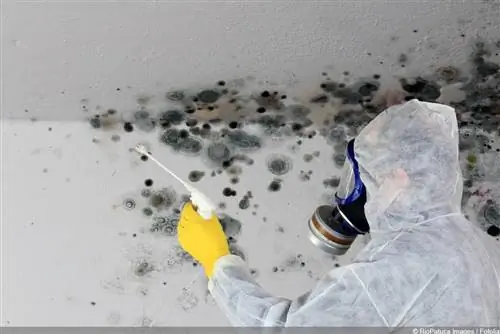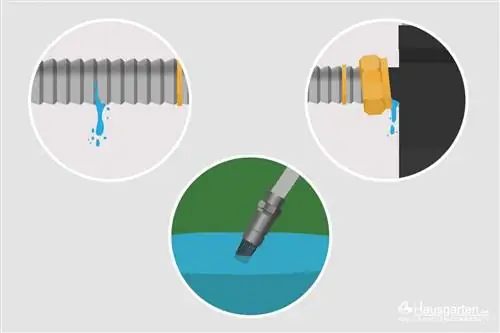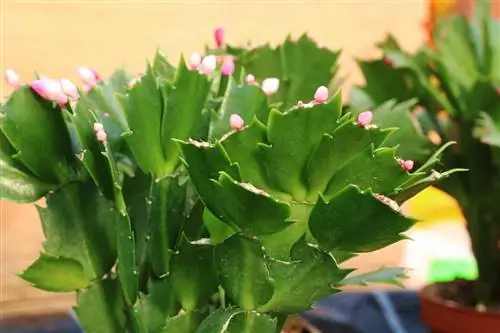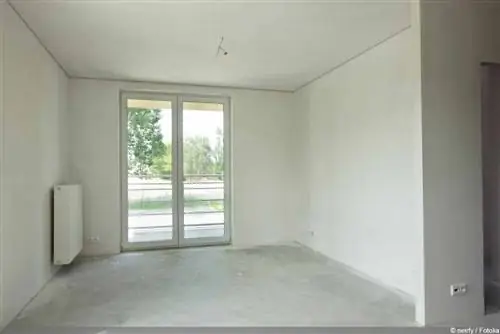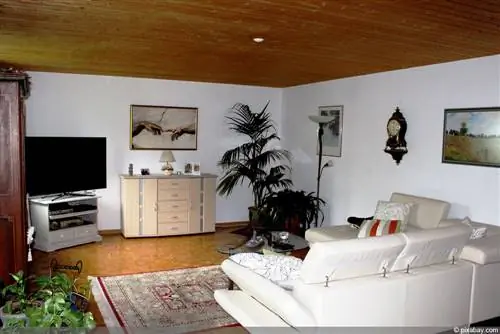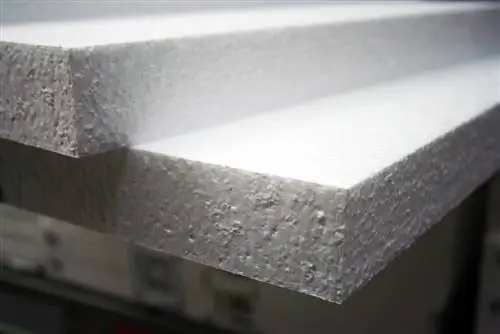- Author admin [email protected].
- Public 2023-12-17 03:39.
- Last modified 2025-01-24 12:45.
Mold on the ceiling is easier to spot than mold spots behind furniture, but mold can sometimes become surprisingly visible. For example, if you stay there for a long time or if the mold is behind the ceiling paneling. If mold infestation is identified beyond doubt, it must be removed in such a way that it cannot come back.
Mold formation
Before eliminating the fungus on the ceiling, it is necessary to look for the cause of the mold formation. Basically, no matter where the mold appears, too much moisture is always responsible. This settles in cold places in the home and forms the perfect breeding ground for mold. This means that there must also be mold spores in the air. However, these are available almost everywhere, which is why food sometimes gets moldy in the refrigerator. Since the mold spores cannot be removed, the breeding ground must be removed. Humidity needs to be reduced.
Water damage in the apartment above
Mold stains on the ceiling, unlike mold behind cupboards or in hidden places, are usually noticed quickly. Larger stains can only occur if the room or apartment is not entered for a long time or if the mold is still within the ceiling covering. If water damage occurs in the apartment above during a longer absence, mold can form on the ceiling. If this damage is not repaired professionally and moisture penetrates the entire floor and ceiling structure. This happens when the cause is repaired, but the moisture itself is not dried sufficiently.
Measures
If there is known water damage in the apartment above, it should definitely be repaired and renovated by a specialist company. The floor may need to be dried for this. If it is a rental apartment, that is the landlord's responsibility. This person is also responsible for removing the mold in the apartment below.
Condominium
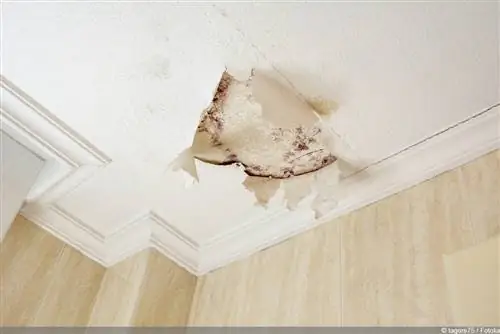
If it is your own apartment, the extent of the mold infestation should first be determined. If it is clear that there is moisture from above, the ceiling paneling is removed. The area is then dried using a fan heater and sufficient ventilation. A hygrometer to measure the humidity or a moisture meter that measures the moisture in the building material is also helpful. Only when it is certain that everything is dry can the ceiling be closed again. Removing the mold itself is unnecessary as it is removed with the ceiling paneling. Only internal, non-removable building materials should be treated against mold.
Leaky roof
Another reason for water intrusion can be a leaky roof if the apartment is directly underneath. This moisture damage also only develops over a long period of time and is not immediately visible. The extent of the damage only becomes apparent when the moisture has penetrated all layers of the roof and the ceiling. If the mold stain becomes visible, simple external measures are no longer sufficient.
Solutions
The roof is being inspected for leaks. These do not have to be directly above the damp area. Water can also run down insulation or roof beams and penetrate the ceiling elsewhere. The leak is eliminated and the damp spot on the ceiling is then renovated. Here, too, chemical mold remover is only necessary for non-removable building materials. And it also applies that the blanket can only be closed again once everything has dried thoroughly.
Structural damage or cold bridges
Cold bridges can occur due to improper or damaged insulation. These are typically located in the corners of exterior walls. Since the walls are particularly cold at this point, water vapor condenses as moisture and mold spores have an easy time.
Measures
First, the general humidity in the room should be reduced so that the mold cannot spread. The outer wall, especially the insulation, must then be inspected for damage. Cold bridges must be eliminated. In the case of a rented apartment, this is the responsibility of the landlord. If the mold stain on the ceiling is only superficial, the area can be cleaned and treated with a chemical mold agent. It is best to use a product without chlorine, as this can be harmful to your he alth, just like the fungus itself.
Humidity too high
Excessive humidity can be the cause of mold formation, especially in the kitchen, bathroom or bedroom. In the kitchen, water vapor is created by cooking, in the bathroom by showering, and in the bedroom, just breathing at night is enough to increase the humidity. In addition, the bedroom is often not very heated, so cold spots quickly form on the walls or ceiling.
Measures
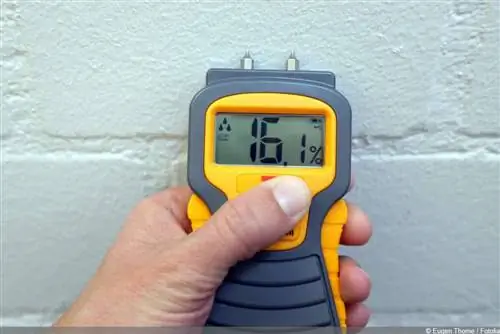
The humidity in the room can be measured with a hygrometer; it should not be higher than 65%. It can be reduced by ventilation. An infrared thermometer measures the temperature of the walls or ceiling. This should not be below the dew point. To determine the temperature at which water vapor precipitates as moisture, there are corresponding tables from which the values can be read. If the temperature of the wall is below this point, the room should be heated more.
Tip:
The mold area itself is cleaned and treated with an appropriate agent. However, these only have a lasting effect if the moisture has not yet penetrated deeply into the ceiling.
Prices for mold removers and aids
- Hygrometer from 15 euros (including thermometer)
- Infrared thermometer from 20 euros
- Moisture meter from 20 euros
- Mold remover from 10 euros
- Large-area mold removal by a specialist company: approx. 1000 euros, depending on the size of the area

